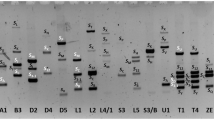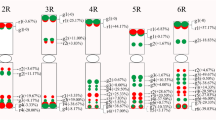Abstract
Papaya (Carica papaya L.) is a major fruit crop in the tropics and is a model system for studying sex chromosome evolution in plants. From a simple sequence repeat (SSR) mapping project in papaya, 37 SSRs displayed non-parental alleles in the F2 population, known as off-type markers. They all belong to Class I (≥20 bp, hypervariable markers). To investigate the molecular basis of these non-parental alleles, seven SSRs with off-type alleles were cloned and sequenced from two parents and selected F2 individuals. SSR repeat motif variation was the major cause for the generation of off-type alleles and single nucleotide polymorphisms (SNPs) and Insertion/deletion also contributed to off-type polymorphism. Off-type SSRs arose after one meiosis at 3 % frequency. Two of the seven markers had no polymorphisms between the parents but non-parental alleles segregated among the F2 individuals. Four of the seven markers exhibited SNPs between parents with transition and transversion at 2:1 ratio. Six markers showed additional SNPs between F2 offspring and parents with transition and transversion at about 1:1 ratio, suggesting higher than expected level of transversion mutations at the F2 population after one meiosis event between the parental genomes. These off-type SSRs were analyzed in a second F2 population and 43 % of them were conserved. The major cause of off-type SSRs in papaya is the variation of repeat length in Type I SSRs, and the underlining mechanism might be DNA replication slippage of repeat motifs. The presence and high conservation of these off-type markers demonstrated that hypervariable class I SSRs could generate genetic variation in one generation and increase genetic diversity for natural selection to enhance fitness.





Similar content being viewed by others
Abbreviations
- AFLP:
-
Amplified fragment length polymorphism
- BAC:
-
Bacterial artificial chromosome
- BES:
-
BAC end sequences
- MSY:
-
Male-specific region of the Y
- SSR:
-
Simple sequence repeat
- SNP:
-
Single nucleotide polymorphisms
- InDel:
-
Insertion and deletion
- WGS:
-
Whole-genome shotgun
- FISH:
-
Fluorescence in situ hybridization
- DAPI:
-
4′,6-Diamidino-2-phenylindole
References
Arumuganathan K, Earle E (1991) Nuclear DNA content of some important plant species. Plant Mol Biol Rep 9(3):208–218
Baudat F, Buard J, Grey C, Fledel-Alon A, Ober C, Przeworski M, Coop G, de Massy B (2009) PRDM9 is a major determinant of meiotic recombination hotspots in humans and mice. Science 327(5967):836–840. doi:10.1126/science.1183439
Blas AL, Ming R, Liu ZY, Veatch OJ, Paull RE, Moore PH, Yu QY (2010) Cloning of the papaya chromoplast-specific lycopene beta-cyclase, CpCYC-b, controlling fruit flesh color reveals conserved microsynteny and a recombination hot spot. Plant Physiol 152(4):2013–2022. doi:10.1104/pp.109.152298
Blas AL, Yu Q, Veatch OJ, Paull RE, Moore PH, Ming R (2012) Genetic mapping of quantitative trait loci controlling fruit size and shape in papaya. Mol Breed 29(2):457–466
Chen C, Yu Q, Hou S, Li Y, Eustice M, Skelton RL, Veatch O, Herdes RE, Diebold L, Saw J (2007) Construction of a sequence-tagged high-density genetic map of papaya for comparative structural and evolutionary genomics in brassicales. Genetics 177(4):2481–2491
Fitch MM, Manshardt RM, Gonsalves D, Slightom JL, Sanford JC (1990) Stable transformation of papaya via microprojectile bombardment. Plant Cell Rep 9(4):189–194. doi:10.1007/BF00232177
Fitch MM, Manshardt RM, Gonsalves D, Slightom JL, Sanford JC (1992) Virus resistant papaya derived from tissues bombarded with the coat protein gene of papaya ringspot virus. Biotechnology 10:1466–1472
Harding RM, Boyce A, Clegg J (1992) The evolution of tandemly repetitive DNA: recombination rules. Genetics 132(3):847–859
Hauge X, Litt M (1993) A study of the origin of ‘shadow bands’ seen when typing dinucleotide repeat polymorphisms by the PCR. Hum Mol Genet 2(4):411–415
Jeffreys AJ, Kauppi L, Neumann R (2001) Intensely punctate meiotic recombination in the class II region of the major histocompatibility complex. Nat Genet 29:217–222
Katti MV, Ranjekar PK, Gupta VS (2001) Differential distribution of simple sequence repeats in eukaryotic genome sequences. Mol Biol Evol 18(7):1161–1167
Kumar P, Chaitanya PS, Nagarajaram HA (2011) PSSRdb: a relational database of polymorphic simple sequence repeats extracted from prokaryotic genomes. Nucleic Acids Res 39(suppl 1):D601–D605
La Rota M, Kantety RV, Yu J-K, Sorrells ME (2005) Nonrandom distribution and frequencies of genomic and EST-derived microsatellite markers in rice, wheat, and barley. BMC Genomics 6(1):23
Levinson G, Gutman GA (1987) Slipped-strand mispairing: a major mechanism for DNA sequence evolution. Mol Biol Evol 4(3):203–221
Li H, Durbin R (2009) Fast and accurate short read alignment with Burrows–Wheeler transform. Bioinformatics 25(14):1754–1760
Li H, Handsaker B, Wysoker A, Fennell T, Ruan J, Homer N, Marth G, Abecasis G, Durbin R (2009) The sequence alignment/map format and SAMtools. Bioinformatics 25(16):2078–2079
Liu S, Liu W, Jakubczak JL, Erexson GL, Tindall KR, Chan R, Muller WJ, Adhya S, Garges S, Merlino G (2002) Genetic instability favoring transversions associated with ErbB2-induced mammary tumorigenesis. Proc Natl Acad Sci USA 99(6):3770–3775
Ma H, Moore PH, Liu Z, Kim MS, Yu Q, Fitch MM, Sekioka T, Paterson AH, Ming R (2004) High-density linkage mapping revealed suppression of recombination at the sex determination locus in papaya. Genetics 166(1):419–436
Ming R, Hou S, Feng Y, Yu Q, Dionne-Laporte A, Saw JH, Senin P, Wang W, Ly BV, Lewis KL (2008) The draft genome of the transgenic tropical fruit tree papaya (Carica papaya Linnaeus). Nature 452(7190):991–996
Morgante M, Hanafey M, Powell W (2002) Microsatellites are preferentially associated with nonrepetitive DNA in plant genomes. Nat Genet 30(2):194–200
Mun J-H, Kim D-J, Choi H-K, Gish J, Debellé F, Mudge J, Denny R, Endré G, Saurat O, Dudez A-M (2006) Distribution of microsatellites in the genome of Medicago truncatula: a resource of genetic markers that integrate genetic and physical maps. Genetics 172(4):2541–2555
Na J-K, Wang J, Murray JE, Gschwend AR, Zhang W, Yu Q, Pérez RN, Feltus FA, Chen C, Kubat Z (2012) Construction of physical maps for the sex-specific regions of papaya sex chromosomes. BMC Genomics 13(1):176
Ossowski S, Schneeberger K, Lucas-Lledó JI, Warthmann N, Clark RM, Shaw RG, Weigel D, Lynch M (2010) The rate and molecular spectrum of spontaneous mutations in Arabidopsis thaliana. Science 327(5961):92–94
Padmanabhan S, Thakur J, Siddharthan R, Sanyal K (2008) Rapid evolution of Cse4p-rich centromeric DNA sequences in closely related pathogenic yeasts, Candida albicans and Candida dubliniensis. Proc Natl Acad Sci USA 105(50):19797–19802
Parvanov ED, Petkov PM, Paigen K (2010) Prdm9 controls activation of mammalian recombination hotspots. Science 327:835
Powell W, Morgante M, Andre C, Hanafey M, Vogel J, Tingey S, Rafalski A (1996) The comparison of RFLP, RAPD, AFLP and SSR (microsatellite) markers for germplasm analysis. Mol Breed 2(3):225–238
Schlötterer C, Tautz D (1992) Slippage synthesis of simple sequence DNA. Nucleic Acids Res 20(2):211–215
Storey W (1969) Papaya. In: Ferwerda FP, Wit F (eds) Outlines of perennial crop breeding in the tropics. Wageningen H. Veenman and Zonen NV, Wageningen
Sugden KD, Campo CK, Martin BD (2001) Direct oxidation of guanine and 7,8-dihydro-8-oxoguanine in DNA by a high-valent chromium complex: a possible mechanism for chromate genotoxicity. Chem Res Toxicol 14(9):1315–1322
Tachida H, Iizuka M (1992) Persistence of repeated sequences that evolve by replication slippage. Genetics 131(2):471–478
Temnykh S, DeClerck G, Lukashova A, Lipovich L, Cartinhour S, McCouch S (2001) Computational and experimental analysis of microsatellites in rice (Oryza sativa L.): frequency, length variation, transposon associations, and genetic marker potential. Genome Res 11(8):1441–1452
Tóth G, Gáspári Z, Jurka J (2000) Microsatellites in different eukaryotic genomes: survey and analysis. Genome Res 10(7):967–981
Wai CM, Ming R, Moore PH, Paull RE, Yu Q (2010) Development of chromosome-specific cytogenetic markers and merging of linkage fragments in papaya. Trop Plant Biol 3(3):171–181. doi:10.1007/s12042-010-9054-1
Walsh PS, Fildes NJ, Reynolds R (1996) Sequence analysis and characterization of stutter products at the tetranucleotide repeat locus vWA. Nucleic Acids Res 24(14):2807–2812
Wang J, Chen C, Na J-K, Yu Q, Hou S, Paull RE, Moore PH, Alam M, Ming R (2008) Genome-wide comparative analyses of microsatellites in papaya. Trop Plant Biol 1(3–4):278–292
Wikström N, Savolainen V, Chase MW (2001) Evolution of the angiosperms: calibrating the family tree. Proc R Soc Lond B Biol 268(1482):2211–2220
Yu Q, Tong E, Skelton RL, Bowers JE, Jones MR, Murray JE, Hou S, Guan P, Acob RA, Luo M-C (2009) A physical map of the papaya genome with integrated genetic map and genome sequence. BMC Genomics 10(1):371
Zhang L, Yuan D, Yu S, Li Z, Cao Y, Miao Z, Qian H, Tang K (2004) Preference of simple sequence repeats in coding and non-coding regions of Arabidopsis thaliana. Bioinformatics 20(7):1081–1086
Zhang W, Wai CM, Ming R, Yu Q, Jiang J (2010) Integration of genetic and cytological maps and development of a pachytene chromosome-based karyotype in papaya. Trop Plant Biol 3(3):166–170
Acknowledgments
This work was supported by a grant from NSF Plant Genome Research Program (Award No. DBI 0922545) and startup fund from Fujian Agriculture and Forestry University to R.M.
Authors’ contribution
RM and RC conceived the study, coordinated all research activities; JF and AW carried out wet lab experiments and conducted bioinformatics analysis; JF, RC and RM wrote the manuscript. All authors read and approved the final manuscript.
Author information
Authors and Affiliations
Corresponding author
Ethics declarations
Conflict of interest
The authors declare that they have no competing interests.
Electronic supplementary material
Below is the link to the electronic supplementary material.
Rights and permissions
About this article
Cite this article
Fang, J., Wood, A., Chen, R. et al. Molecular basis of off-type microsatellite markers in papaya. Euphytica 209, 323–339 (2016). https://doi.org/10.1007/s10681-015-1630-x
Received:
Accepted:
Published:
Issue Date:
DOI: https://doi.org/10.1007/s10681-015-1630-x




